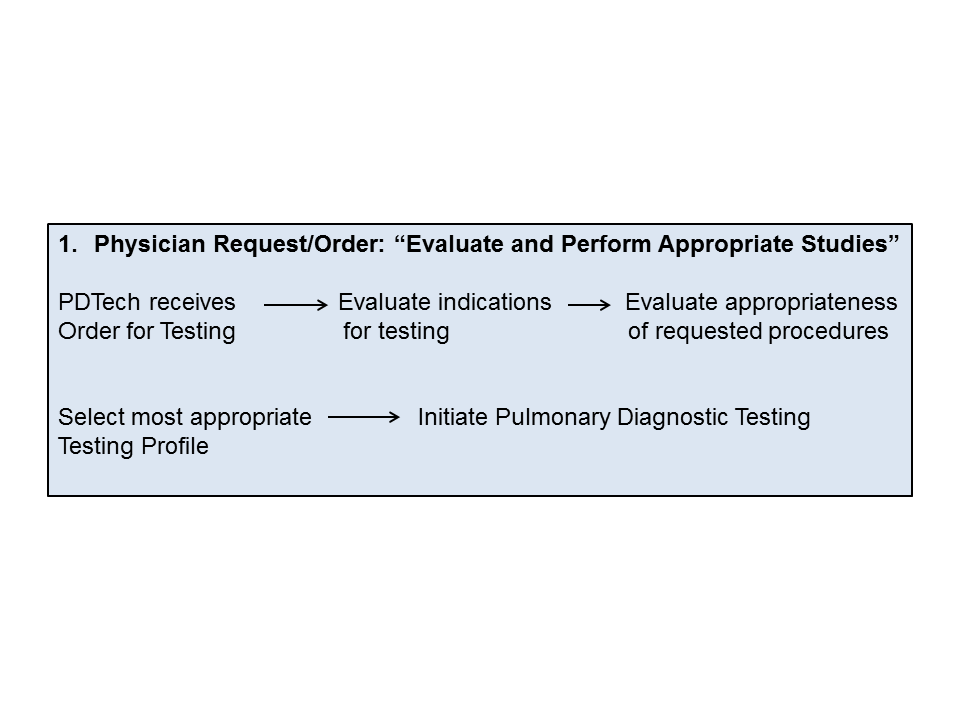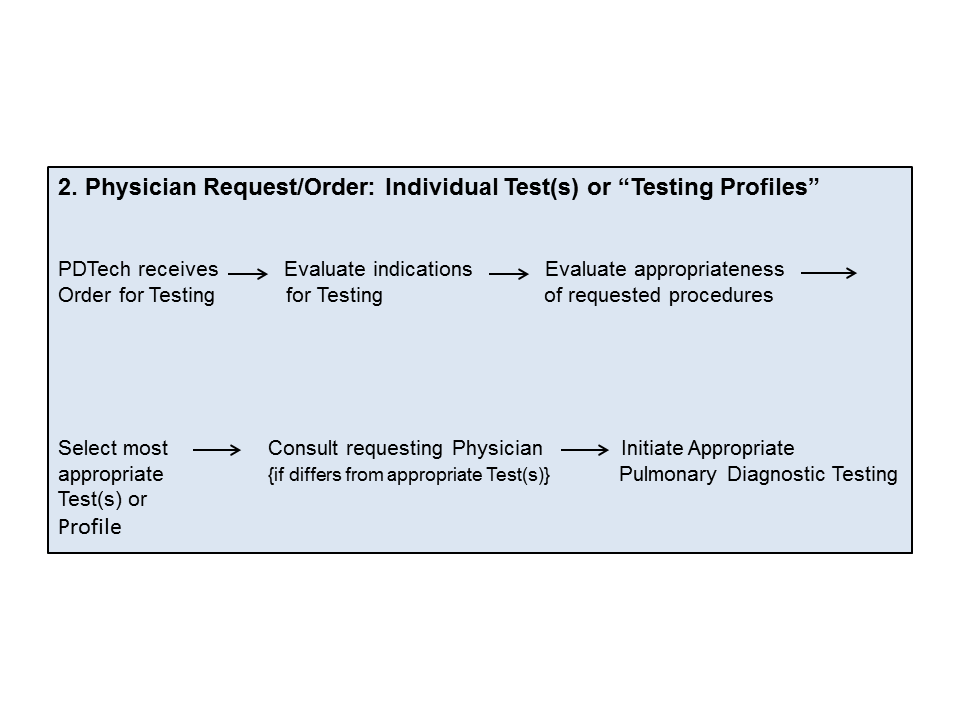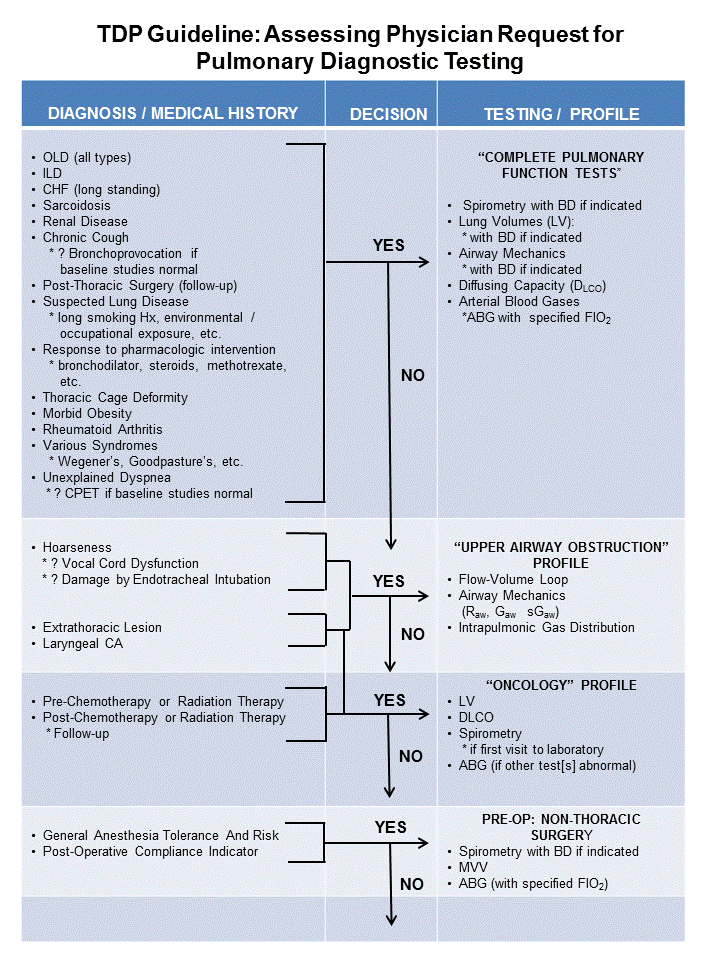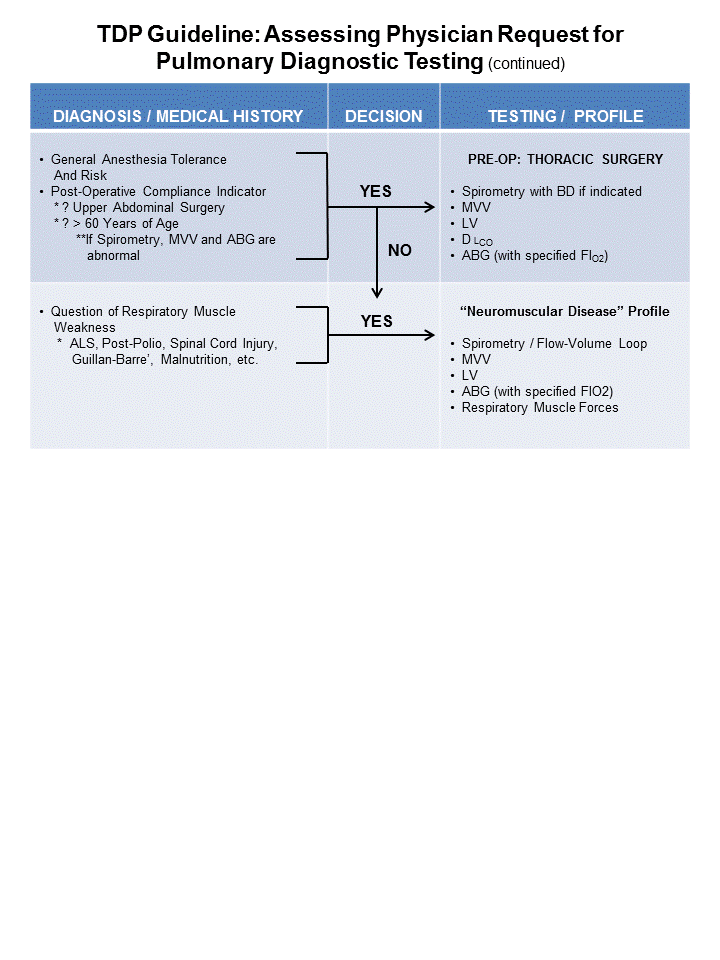I. PROTOCOL: ASSESSMENT OF PHYSICIAN REQUEST FOR PULMONARY DIAGNOSTIC TESTING1
II. PURPOSE: To maintain continuity and assure appropriateness of physician orders for pulmonary diagnostic testing. The Pulmonary Diagnostic Technologist (PDT) will evaluate each request for pulmonary diagnostic testing, with regard to diagnosis or past medical history relative to requested procedures. If the requested testing does not conform to this protocol, the PDT will notify the requesting physician and recommend appropriate test(s).
III. PATIENT TYPE: All patients referred, for testing, to the Pulmonary Diagnostic Services.
IV. TESTING AREA: Pulmonary Diagnostic Laboratories (adult and pediatric sites) and inpatient areas (bedside assessment).
V. EQUIPMENT AND FORMS NEEDED:
1. Calibrated (with verified calibration) pulmonary diagnostic equipment: Spirometer, Helium, Nitrogen and Carbon Monoxide analyzers, total body plethysmograph, pH-Blood Gas Analyzer and Hemoximeter, CPET equipment (including analyzers), related equipment for Respiratory Muscle Forces
2. Physician order (written, electronically generated, verbal), or “Request for Pulmonary Diagnostic Testing”
3. Guideline for Assessing Request for Pulmonary Diagnostic Testing
VI. OVERVIEW: The PDT will assess each request received by the Pulmonary Diagnostic Services.


VII. PROTOCOL: The following guidelines will be followed when assessing appropriateness of physician requests for Pulmonary Diagnostic testing and are indicated by the PDT Assessment Protocol.
- The following conditions are accepted indications for Pulmonary Diagnostic Testing: 2
To determine
A. the presence and extent of lung disease or abnormality of lung function
B. the extent of disability due to abnormal lung function
C. the type and progression of the disease or lesion
D. a course of therapy in treatment of the particular lesion.
2. The selection of the appropriate pulmonary function test profile will be based upon the following: 3,4,5,6,7,8
A. Indications for Pulmonary Diagnostic Testing will include:
1) To detect the presence or absence of lung dysfunction suggested by history or physical indicators (e.g., age, smoking history, family history of lung disease, cough, dyspnea) and/or the presence of other abnormal diagnostic tests (e.g., chest x-ray, arterial blood gases)
2) To differentiate types and quantify the severity of known lung disease
3) To assess the change in lung function over time or following administration of, or change of, therapy
4) To assess the potential effects or response to environmental or occupational exposure
5) To assess the risk for surgical procedures known to affect lung function
B. Pulmonary Diagnostic Tests available include (but are not limited to):
1) Spirometry with
a. evaluation of acute response to beta-agonist if airflow limitation is present,
b. inspiratory limb if upper airway dysfunction suspected (Flow-Volume Loop)
2) Maximum Voluntary ventilation (MVV)
3) Lung Volumes (LV {Plethysmographic or gas dilution}):
a. with evaluation of acute response to beta-agonist if airflow limitation is present
4) Airway Mechanics (Raw,Gaw sGaw)
a. with evaluation of acute response to beta-agonist if airflow limitation is present
5) Single-Breath Diffusing Capacity (DLCO)
6) Intrapulmonic Gas Distribution (SBN2, N2WO,or HMT)
7) Arterial Blood Gases (includes Hemoximetry)
8) Respiratory Muscle Forces (RMF)*
a. If Lung Volumes performed: MEP at FRC & TLC, MIP at FRC & RV
b. Otherwise MIP & MEP only: AKA Maximal Occluding Pressure measurements
3. The following guidelines will be utilized in the evaluation and selection of the appropriate pulmonary diagnostic tests for indicated diagnoses or medical history:
A. Indications for initial pulmonary evaluation employing the “Complete Pulmonary Function Tests“ Testing Profile: Spirometry {with beta-agonist if indicated}, Lung Volumes {LV}, Airway Mechanics {Raw}, Diffusing Capacity {DLCO}, Arterial Blood Gases (ABG with specified FIO2) include, but are not limited to:
1) Obstructive Lung Disease (OLD)
2) Interstitial Lung Disease (ILD)
3) Long standing Congestive Heart Failure (CHF)
4) Sarcoidosis
5) Renal Disease
6) Chronic Cough :Bronchoprovocation with non-specific pharmacologic agent, or exercise-induced with frigid-air inhalation, may be indicated if baseline studies do not show evidence of pulmonary dysfunction: See also TDP “Bronchial Provocation”
7) Post-Thoracic Surgery: To serially monitor pulmonary changes
8) Suspected Lung Disease: Long smoking history, environmental/occupational exposure, etc.
9) Response to Drug Therapy: Bronchodilator, steroids, methotrexate, amiodarone, etc.
10) Thoracic Cage Deformity
11) Morbid Obesity
12) Rheumatoid Arthritis
13) Various Syndromes: Wegener’s, Goodpasture’s, etc.
14) Unexplained Dyspnea
a. Perform LV via Plethysmography and Gas Dilution to quantify “unventilated lung”
b. Cardio-Pulmonary Exercise Test {CPET}: progressive maximal and/or steady-state may be indicated if baseline studies do not provide evidence of pulmonary dysfunction
B. Indications for pulmonary evaluation employing the “Upper Airway Obstruction Profile” (Flow-Volume Loop, Raw, SBN2) include, but are not limited to:
1) Hoarseness
a. Rule out vocal cord dysfunction
b. Rule out damage done by endotracheal tube
c. Quantifies contribution of larger versus smaller airways, if airflow limitation is present
2) Extrathoracic lesion
3) Laryngeal cancer
C. Indications for pulmonary evaluation employing the “Oncology Profile” (LV, DLCO, Spirometry {if first time visit to laboratory}, ABG {if other tests are abnormal}) include, but are not limited to:
1) Pre-Oncolytic Therapy: Chemotherapy and/or Radiation therapy
2) Post-Oncolytic Therapy: Monitor at regular intervals; during and after completion of therapeutic regime(s)
3) Include “Upper Airway Obstruction Profile” if subject presents with a cancerous extrathoracic lesion or has laryngeal cancer.
D. Indications for pulmonary evaluation employing the “Pre-OP: Non-Thoracic Surgery” Testing Profile (Spirometry with beta-agonist if indicated, MVV, ABG) include, but are not limited to:
1) General anesthesia toleration and risk
2) Post-operative compliance indicator: If MVV FEV1 X 35 or 41 and there is no suspicion or indication of Respiratory Muscle weakness (ie, reduced value is due to poor effort), subject may be a noncompliant post-surgical candidate with bronchial hygiene (eg, voluntary volume expansion protocols)
E. Indications for pulmonary evaluation employing the “Pre-OP: Thoracic Surgery” Testing Profile (Spirometry with beta-agonist if indicated, MVV, LV, DLCO, ABG) include, but are not limited to:
1) General anesthesia toleration and risk
2) Post-operative compliance indicator
3) Baseline spirometry, MVV and ABG are abnormal and the subject
a. is being evaluated for upper abdominal surgery &/or
b. is > 60 years of age &/or
c. has a history of tobacco abuse
F. Indications for pulmonary evaluation employing the “Neuromuscular Disease Profile” (Flow-Volume Loop, MVV, LV, ABG and RMF) include, but are· not limited to:
1) Question of Respiratory Muscle Weakness ALS, Post-Polio, spinal cord injury, Guillain-Barre’, Malnutrition, etc.
2) Monitor disease progression or response to therapy
VIII. GUIDELINES / WARNINGS:
- Monitor patient’s heart rate (before, during and after) beta-agonist administration. The need to change medication may be indicated by:
A. A heart rate greater than 120 bpm, or if a pulse increase of 20 bpm occurs with bronchodilator medication. Technologist statement must appear on the final report.
B. Patient is receiving noncardioselective beta-blocker therapy.
2. After repeated forced expiratory efforts, worsening of some pulmonary function parameters (e.g., FEV1 , instantaneous flows, airway mechanics) may indicate airway hyperreactivity.
NOTE: This may spontaneously subside, or may require treatment with beta agonist.
3. Although rare, syncopal episodes do occur with forced expiratory maneuvers.
4. There is the possibility of transmission of airborne diseases either from the technologist to the subject, or from the subject to the technologist.
5. Frank hemoptysis warrants immediate discontinuance of testing.
A. A significantly elevated DLCO value may be an early warning of intrapulmonic hemorrhage6.
6. Universal Precautions must be followed with all blood and blood tinged articles10.
7. Technologist test “Quality statements” must accompany all final reports.
A. Technologist should never report values which do not reflect the patient’s true pulmonary physiology.
1) The Technologist needs to provide clear documentation as to why results were not reported. For example, “Despite repeated varying instructions and demonstrations, the subject either could not, or would not, perform the specific test(s) in an acceptable and reproducible manner. Because of this no data are being reported at this time.”
2) Alternatively, the subject may not be able to perform the test according to professional society recommendations. In this instance the PDT migh be able to report select data from the test with quality notes outlining the rationale behind the decision.
a. Spirometry as an example: “Despite repeated varying instructions and demonstrations, the subject was unable to forcefully exhale longer than 3 seconds. Therefore, only the FEV1, PEF and FVC are reported as other instantaneous flows would be over-estimated since the FVC is probably under-estimated.”
IX. TECHNOLOGIST RESPONSIBILITY:
- The Assessment of Physician Request for Pulmonary Diagnostic Testing Protocol guidelines will be used to re-evaluate all patients referred for testing to the Pulmonary Diagnostic Laboratory.
- Immediately notify the requesting physician if Subject experiences an untoward event during testing (e.g., Vaso-vagal response) or if arterial blood gas results fall within the “Panic Value / Physician Alert”11 range(s).
- Inform Pulmonary Diagnostic Services Directors (Medical and Technical) about physicians who are repeatedly reluctant to comply with PDTech recommendations to alter requested procedures to those that are more appropriate. NOTE: As a component of the Pulmonary Diagnostic Services Continuous Quality Improvement program, the Medical Director may need to reeducate. these recalcitrant ordering physicians, with this matter.
X. SUPPORTING REFERENCES (these were initial references where others may be included; e.g., ATS Pulmonary Function Laboratory Management and Procedure Manual, ATS/ERS Procedural Recommendations, etc.)
1. “Assessment of Physician Requests for Pulmonary Function Testing”, Brown, R. Cardiopulmonary section Bulletin, American Association for Respiratory Care, Fall 1991.
2. Ruppel G. Manual of pulmonary function testing, 3rd ed., Mosby Year-Book Publishers, 1992.
3. American Association for Respiratory Care Clinical Practice Guideline: Spirometry. Respir Care 1991;36(12):1414-1417.
4. American Association for Respiratory Care Clinical Practice Guideline: Sampling for Arterial Blood Gas Analysis. Respir Care 1992;37(8):913-917.
5. American Association for Respiratory Care Clinical Practice Guideline: In-vitro pH-Blood Gas Analysis and Hemoximetry. Respir Care 1993;38(5):505-510.
6. American Association for Respiratory Care Clinical Practice Guideline: Single-Breath Diffusing Capacity. Respir Care 1993;38(5):511-515.
7. American Association for Respiratory Care Clinical Practice Guideline: Static Lung Volumes. Respir Care 1994;39:830-836.
8. American Association for Respiratory Care Clinical Practice Guideline: Body Plethysmography. Respir Care 1994;39:1184-1190.
9. Centers for Disease Control. Guidelines for preventing the transmission of tuberculosis in health care settings with special focus on HIV-related issues. MMWR 1990;39:1-29.
10. Centers for Disease Control. Update: universal precautions for prevention of transmission of human immunodeficiency virus, hepatitis B virus, and other bloodborne pathogens in health care settings. MMWR 1988;37:377-388.
11. Department of Health and Human Services Health Care Financing Administration Public Health Service 42 CFR part 405, et al. Clinical Laboratory Improvement Amendments of 1988; Final Rule. Federal Register Friday February 28, 1992.
==========================================================================================================
TDP Guideline: Assessing Physician Request for Pulmonary Diagnostic Testing Flow Chart:


Go to Indications Based Initial Subject Evaluation TDP at: https://pftlabresources.com/tdp-indications-based-pulmonary-diagnostics-initial-subject-evaluation/